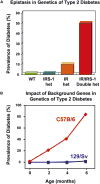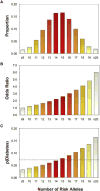The emerging genetic architecture of type 2 diabetes
- PMID: 18762020
- PMCID: PMC4267677
- DOI: 10.1016/j.cmet.2008.08.006
The emerging genetic architecture of type 2 diabetes
Abstract
Type 2 diabetes is a genetically heterogeneous disease, with several relatively rare monogenic forms and a number of more common forms resulting from a complex interaction of genetic and environmental factors. Previous studies using a candidate gene approach, family linkage studies, and gene expression profiling uncovered a number of type 2 genes, but the genetic basis of common type 2 diabetes remained unknown. Recently, a new window has opened on defining potential type 2 diabetes genes through genome-wide SNP association studies of very large populations of individuals with diabetes. This review explores the pathway leading to discovery of these genetic effects, the impact of these genetic loci on diabetes risk, the potential mechanisms of action of the genes to alter glucose homeostasis, and the limitations of these studies in defining the role of genetics in this important disease.
Figures




Similar articles
-
[Comeback for the beta cells in the pathogenesis of diabetes].Lakartidningen. 2010 Nov 10-16;107(45):2796-800. Lakartidningen. 2010. PMID: 21179864 Review. Swedish. No abstract available.
-
Two Novel Candidate Genes for Insulin Secretion Identified by Comparative Genomics of Multiple Backcross Mouse Populations.Genetics. 2018 Dec;210(4):1527-1542. doi: 10.1534/genetics.118.301578. Epub 2018 Oct 19. Genetics. 2018. PMID: 30341086 Free PMC article.
-
Identification of seven loci for static glucokinesis and dynamic glucokinesis in mice.Mamm Genome. 2002 Jun;13(6):293-8. doi: 10.1007/s00335-001-2134-7. Mamm Genome. 2002. PMID: 12115031
-
RD Lawrence Lecture 2009. Old genes, new tricks: learning about blood glucose regulation from naturally occurring genetic variation in humans.Diabet Med. 2009 Nov;26(11):1083-9. doi: 10.1111/j.1464-5491.2009.02860.x. Diabet Med. 2009. PMID: 19929985
-
Recent progress in genetic and epigenetic research on type 2 diabetes.Exp Mol Med. 2016 Mar 11;48(3):e220. doi: 10.1038/emm.2016.7. Exp Mol Med. 2016. PMID: 26964836 Free PMC article. Review.
Cited by
-
Short-term physical exercise controls age-related hyperinsulinemia and improves hepatic metabolism in aged rodents.J Endocrinol Invest. 2023 Apr;46(4):815-827. doi: 10.1007/s40618-022-01947-8. Epub 2022 Nov 1. J Endocrinol Invest. 2023. PMID: 36318449
-
The Tellurium compound, AS101, increases SIRT1 level and activity and prevents type 2 diabetes.Aging (Albany NY). 2012 Jun;4(6):436-47. doi: 10.18632/aging.100468. Aging (Albany NY). 2012. PMID: 22761194 Free PMC article.
-
A systems biology approach identifies inflammatory abnormalities between mouse strains prior to development of metabolic disease.Diabetes. 2010 Nov;59(11):2960-71. doi: 10.2337/db10-0367. Epub 2010 Aug 16. Diabetes. 2010. PMID: 20713682 Free PMC article.
-
Risk of cancer following hospitalization for type 2 diabetes.Oncologist. 2010;15(6):548-55. doi: 10.1634/theoncologist.2009-0300. Epub 2010 May 17. Oncologist. 2010. PMID: 20479278 Free PMC article.
-
Obesity genetics and cardiometabolic health: Potential for risk prediction.Diabetes Obes Metab. 2019 May;21(5):1088-1100. doi: 10.1111/dom.13641. Epub 2019 Mar 20. Diabetes Obes Metab. 2019. PMID: 30667137 Free PMC article. Review.
References
-
- Almind K, Kulkarni RN, Lannon SM, Kahn CR. Identification of Interactive Loci Linked to Insulin and Leptin in Mice With Genetic Insulin Resistance. Diabetes. 2003;52:1535–1543. - PubMed
-
- Altshuler D, Hirschhorn JN, Klannemark M, Lindgren CM, Vohl MC, Nemesh J, Lane CR, Schaffner SF, Bolk S, Brewer C, et al. The common PPARgamma Pro12Ala is associated with decreased risk of type 2 diabetes. Nat Genet. 2000;26:76–80. - PubMed
-
- Barroso I, Gurnell M, Crowley VE, Agostini M, Schwabe JW, Soos MA, Maslen GL, Williams TD, Lewis H, Schafer AJ, et al. Dominant negative mutations in human PPARgamma associated with severe insulin resistance, diabetes mellitus and hypertension. Nature. 1999;402:880–883. - PubMed
Publication types
MeSH terms
Substances
Grants and funding
LinkOut - more resources
Full Text Sources
Other Literature Sources
Medical

